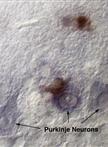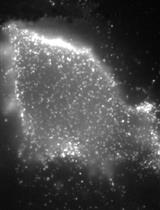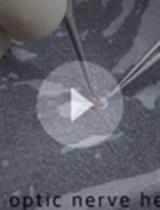Materials and Reagents
- Raw264.7, MCF-7 or Hela cells
- DPBS (Life Technologies, InvitrogenTM, catalog number: 14190-250 )
- FBS (Atlanta Biologicals, catalog number: S11110H )
- Anti-fade mounting medium: e.g. ProLong Gold Antifade Mountant (Life Technologies, InvitrogenTM, catalog number: P10144 ) with DAPI (if nuclear staining is needed) or without DAPI
- Paraformaldehyde (Sigma-Aldrich, catalog number: 158127 )
- General chemicals (Sigma-Aldrich)
- Triton X-100 (Sigma-Aldrich, catalog number: T8787 )
- Tween 20 (Sigma-Aldrich, catalog number: P2287 )
- 4% paraformaldehyde-freshly-prepared (5 ml) (see Recipes)
- Antibodies (see Recipes)
Equipment
- Round cover slips (Thermo Fisher Scientific)
- 24-well plate
- Fluorescence microscope
Procedure
- Grow cells on round cover slips in 24-well plates to 30-60% confluence. Do not overgrow because it will be difficult to distinguish cell components when stained.
- Wash cells with 500 μl/well DPBS twice, then add 250 μl/well 4% paraformaldehyde for 15 min at room temperature (RT).
- Remove paraformaldehyde, wash the fixed cells with 500 μl/well PBS + 3% FBS for 3 times.
- Permeabilize cells with 250 μl/well DPBS + 0.2% Triton X-100 for 5 min, then wash with 500 μl/well DPBS + 3% FBS for 3 times.
- Block with 500 μl/well DPBS + 3% FBS + 0.5% Tween 20 for 1 h at RT.
- Remove the blocking buffer, add 250 μl/well primary antibodies and incubate at RT for 1 h.
- Remove the antibodies, wash with 500 μl/well DPBS + 3% FBS in 5 min for 3 times.
- Add 250 μl/well fluorescent secondary antibodies and incubate at RT for 30 min.
- Remove the antibodies, wash with 500 μl/well DPBS + 3% FBS in 5 min for 3 times.
- Place a small drop of anti-fade reagent on a glass slide, then get the cover slip from the well and put it face down on the drop, push it tightly and attach to the glass slide.
- Leave the slide in the dark for 5 min to let it dry.
- The slide now it is ready to observe under a fluorescence microscope.
Recipes
- 4% paraformaldehyde-freshly-prepared (5 ml)
0.2 g paraformaldehyde powder + 5 ml DPBS + 50 μl 1 N NaOH
Incubate at 65 °C
Vortex several times to dissolved completely
Cool at room temperature then add 4 μl HCl
Mixed completely
- Antibodies
Diluted in DPBS + 3% FBS + 0.5 Tween 20
Primary antibodies: 1:100-1:500 (depends on individual antibodies)
Fluorescent secondary antibodies: 1:800
Acknowledgments
This work was funded by 5050 project by Hangzhou Hi-Tech District, Funding for Oversea Returnee by Hangzhou City, ZJ1000 project by Zhejiang Province. This protocol was developed in the Cohen Lab, Department of Genetics, Stanford University, CA, USA [Chen et al. (unpublished)].
References
- Agrawal, S., van Dooren, G. G., Beatty, W. L. and Striepen, B. (2009). Genetic evidence that an endosymbiont-derived endoplasmic reticulum-associated protein degradation (ERAD) system functions in import of apicoplast proteins. J Biol Chem 284(48): 33683-33691.
Article Information
Copyright
© 2012 The Authors; exclusive licensee Bio-protocol LLC.
Category
Cell Biology > Cell imaging > Fluorescence
Biochemistry > Protein > Immunodetection > Immunostaining












